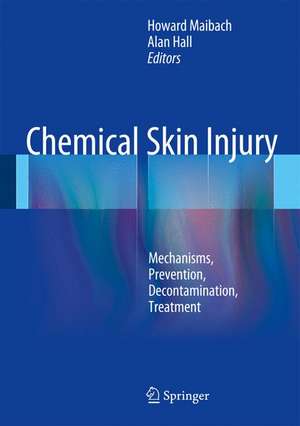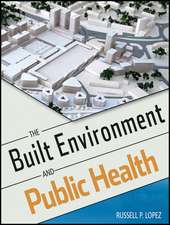Chemical Skin Injury: Mechanisms, Prevention, Decontamination, Treatment
Editat de Howard I. Maibach, Alan H. Hallen Limba Engleză Hardback – 25 sep 2014
| Toate formatele și edițiile | Preț | Express |
|---|---|---|
| Paperback (1) | 712.94 lei 39-44 zile | |
| Springer Berlin, Heidelberg – 22 sep 2016 | 712.94 lei 39-44 zile | |
| Hardback (1) | 1105.61 lei 3-5 săpt. | |
| Springer Berlin, Heidelberg – 25 sep 2014 | 1105.61 lei 3-5 săpt. |
Preț: 1105.61 lei
Preț vechi: 1163.80 lei
-5% Nou
Puncte Express: 1658
Preț estimativ în valută:
211.56€ • 220.45$ • 175.17£
211.56€ • 220.45$ • 175.17£
Carte disponibilă
Livrare economică 13-27 martie
Preluare comenzi: 021 569.72.76
Specificații
ISBN-13: 9783642397783
ISBN-10: 3642397786
Pagini: 350
Ilustrații: X, 241 p. 259 illus., 219 illus. in color.
Dimensiuni: 178 x 254 x 17 mm
Greutate: 0.7 kg
Ediția:2014
Editura: Springer Berlin, Heidelberg
Colecția Springer
Locul publicării:Berlin, Heidelberg, Germany
ISBN-10: 3642397786
Pagini: 350
Ilustrații: X, 241 p. 259 illus., 219 illus. in color.
Dimensiuni: 178 x 254 x 17 mm
Greutate: 0.7 kg
Ediția:2014
Editura: Springer Berlin, Heidelberg
Colecția Springer
Locul publicării:Berlin, Heidelberg, Germany
Public țintă
Professional/practitionerCuprins
Skin in the Past and in the Modern Times.- Normal Skin Aspects.- Molecular Dimension of Skin Chemical Aggression.- Damaged Skin.- Practical Aspects of Skin Chemical Exposure and Management.
Notă biografică
Alan H. Hall, M.D., is a board-certified Medical Toxicologist and is President and Chief Medical Toxicologist of Toxicology Consulting and Medical Translating Services, Inc., Laramie, Wyoming. He is also Clinical Assistant Professor at the Colorado School of Public Health, University of Colorado-Denver, Denver, Colorado. He was formerly Clinical Assistant Professor of Preventive Medicine and Biometrics and Assistant Professor of Pediatrics at the University of Colorado School of Medicine, and Research Assistant Professor in the Division of Medical Toxicology, Department of Emergency Medicine, Texas Tech University Health Sciences Center, El Paso, Texas. He received his undergraduate degree from Indiana University South Bend, South Bend, Indiana, from which university he has Division and University-wide Distinguished Alumnus awards. He received his Doctor of Medicine degree from the Indiana University School of Medicine, Indianapolis, Indiana. Dr. Hall has been in general practice, trained in Anesthesiology, and practiced Occupational and Environmental Medicine and Emergency Medicine. He was a board-certified Emergency Physician for 20 years. He is an honorarily retired United States Air Force Reserve Flight Surgeon. Dr. Hall was the inventor and for many years Director/Editor and Editor-in-Chief of the TOMES Plus (Toxicology, Occupational Medicine, and Environmental Series) databases at Micromedex, Inc., Denver and Englewood, Colorado. He has a particular interest in occupational and environmental chemical exposures, toxic gases, toxic terrorism preparedness and prevention, Advanced Hazardous Materials Life Support (he is an AHLS verified provider and instructor and a member of the Scientific Advisory Committee), cyanide poisoning/smoke inhalation and its antidotal treatment, and decontamination of skin/eye chemical splashes. Dr. Hall has been a consultant or peer reviewer for U.S. government agencies including DOL, DOE, ATSDR, NIH, and EPA, and was amember of a Toxicology Subcommittee of the National Research Council on Submarine Emergency Action Levels for toxic gases released during nuclear submarine disasters. He is a peer reviewer for several medical/scientific journals and textbook publishers. Dr. Hall has more than 90 scientific publications in peer-reviewed journals and textbooks, and lectures worldwide on various Medical Toxicology issues. He is also a professional translator of medical/scientific information from several languages into English. Dr. Hall is a member-at-large of the American Chemical Society Division of Chemical Health and Safety Executive Committee.
Textul de pe ultima copertă
This book provides an up-to-date, compact but comprehensive review of chemical skin injuries, differentiating them from thermal skin burns. After an introductory chapter on the history of chemical skin injuries and the scope of the problem, the anatomy, histology, physiology, and immunology of normal skin are described. Mechanisms involved in chemical penetration of normal skin are explained, and the effects of damaged skin on chemical penetration are analyzed. The remainder of the book discusses a variety of clinically relevant aspects, such as the different forms of chemical skin injury, including injuries that arise during skin peeling or due to hair products; preventive measures; emergency treatment; rinsing therapy; medical and surgical treatment; and the importance of providing relevant information to workers. The role of predictive toxicology is also considered.
Chemical Skin Injury: Mechanisms, Prevention, Decontamination, Treatment is an ideal resource for readers who want to understand chemical skin injury, to put preventive measures in place, and to respond appropriately should a chemical skin injury occur.
Chemical Skin Injury: Mechanisms, Prevention, Decontamination, Treatment is an ideal resource for readers who want to understand chemical skin injury, to put preventive measures in place, and to respond appropriately should a chemical skin injury occur.
Caracteristici
The only comprehensive work specifically on chemical skin injuries Differentiates between chemical skin injury and thermal skin burns Focuses on particular situations, such as injuries caused by commonly used chemicals Describes effective preventive measures Explains how to prevent or mitigate the effects of chemical skin exposures in industrial settings















